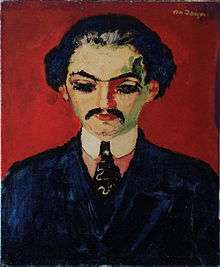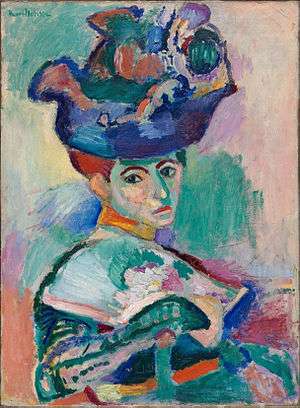Kees van Dongen
Cornelis Theodorus Maria 'Kees' van Dongen (26 January 1877 – 28 May 1968) was a Dutch-French painter who was one of the leading Fauves.[2] Van Dongen's early work was influenced by the Hague School and symbolism and it evolved gradually into a rough pointillist style. From 1905 onwards – when he took part at the controversial 1905 Salon d'Automne exhibition – his style became more and more radical in its use of form and colour. The paintings he made in the period of 1905–1910 are considered by some to be his most important works.[3] The themes of his work from that period are predominantly centered around the nightlife; he paints dancers, singers, masquerades and theatre. Van Dongen gained a reputation for his sensuous – at times garish – portraits of especially women.
Kees van Dongen | |
|---|---|
 Van Dongen in his studio c. 1910 | |
| Born | Cornelis Theodorus Maria van Dongen 26 January 1877[1] |
| Died | 28 May 1968 (aged 91) |
| Nationality | Dutch, French |
| Known for | Painting |
| Movement | Fauvism |
Life and work
Kees van Dongen was born in Delfshaven, then on the outskirts, and today a borough, of Rotterdam. He was the second of four children in a middle-class family.[4] In 1892, at age 16, Kees van Dongen started his studies at the Royal Academy of Fine Arts in Rotterdam, working with J. Striening and J.G. Heyberg.[4] During this period (1892–97), Van Dongen frequented the Red Quarter seaport area, where he drew scenes of sailors and prostitutes. He met Augusta Preitinger at the Academy, a fellow painter.

In 1897, Van Dongen lived in Paris for several months, where there was a large emigre community. In December 1899, he returned from Rotterdam to Paris, where Preitinger had moved before him and found work.[4]
Marriage and family
He returned to join Augusta Preitinger ("Guus"), whom he had met at the Academy. They married on 11 July 1901. They had two children together: a son died a couple of days after birth in December 1901; their daughter Augusta, called "Dolly", was born 18 April 1905. Around that time, Van Dongen produced a painting of Fernande Olivier, which was the reason why — according to Gertrude Stein in The Autobiography of Alice B. Toklas — he broke into notoriety. Apparently, according to Stein:
Van Dongen did not admit that this picture was a portrait of Fernande, although she had sat for it and there was in consequence much bitterness. Van Dongen in these days was poor, he had a dutch wife who was a vegetarian and they lived on spinach. Van Dongen frequently escaped from the spinach to a joint in Montmartre where the girls paid for his dinner and his drinks.[5]
Guus took Dolly to see their families in Rotterdam in the summer of 1914, where they were caught by the outbreak of World War I. They were not able to return to Paris until 1918. Preitinger and Van Dongen divorced in 1921.[6]
In 1917, Van Dongen had become involved with a married socialite, the fashion director Léa Alvin, also known as Jasmy Jacob. Their relationship lasted until 1927.[7]
Career

Van Dongen began to exhibit in Paris, and participated in the controversial 1905 Salon d'Automne exhibition[8] along with Henri Matisse, André Derain, Albert Marquet, Maurice de Vlaminck, Charles Camoin, and Jean Puy. The bright colours of this group of artists led to them being called Fauves ('Wild Beasts') by art critic Louis Vauxcelles.[9] Van Dongen was also briefly a member of the German Expressionist group Die Brücke.
In these years, he was part of an avant-garde wave of painters, including Maurice de Vlaminck, Othon Friesz, Henri Rousseau, Robert Delaunay, Albert Marquet, Édouard Vuillard, who aspired to a renewal of painting which they thought was stuck in neo-impressionism.
In 1906, Preitinger and Van Dongen moved to the Bateau Lavoir at 13 rue Ravignan in Montmartre, where they were friends with the circle surrounding Pablo Picasso and his girlfriend Fernande Olivier.[10] He taught at the Académie Vitti in 1912.[11]
In addition to selling his paintings, Van Dongen also gained an income by selling satirical sketches to the newspaper Revue Blanche. He also organised very successful costume balls in Montparnasse, to which people paid admission, to gain extra income.
After the First World War, under the influence of his companion, the fashion director Lea Alvin (Jasmy Jacob), among others, Van Dongen developed the lush colours of his Fauvist style. This earned him a solid reputation with the French bourgeoisie and upper class, where he was in demand for his portraits. As a fashionable portraitist, he was commissioned for subjects including Arletty, Louis Barthou, Sacha Guitry, Leopold III of Belgium, Anna de Noailles, Madame Grès and Maurice Chevalier.
With a playful cynicism he remarked of his popularity as a portraitist with high society women, "The essential thing is to elongate the women and especially to make them slim. After that it just remains to enlarge their jewels. They are ravished."[12] This remark is reminiscent of another of his sayings: "Painting is the most beautiful of lies".[12]
The social and commercial appeal of his later work (such as a 1959 portrait of Brigitte Bardot in a little black dress, with her hair tousled) did not match the artistic promise or the bohemian eroticism of his first three decades of work.[13]
From 1959, Kees van Dongen lived in Monaco. He died in his home in Monte Carlo in 1968.[14] An extensive collection of van Dongen's work is held by the New National Museum of Monaco.[15] His work was also part of the painting event in the art competition at the 1932 Summer Olympics.[16]
Selected works
%2C_oil_on_canvas%2C_129.5_x_195.5_cm.jpg) Femme aux bas noirs (Woman with Black Stockings), c. 1907, oil on canvas, 129.5 cm × 195.5 cm (51.0 in × 77.0 in)
Femme aux bas noirs (Woman with Black Stockings), c. 1907, oil on canvas, 129.5 cm × 195.5 cm (51.0 in × 77.0 in)%2C_oil_on_canvas%2C_105.5_x_164_cm%2C_Nouveau_Mus%C3%A9e_National_de_Monaco.jpg) Les lutteuses (Lutteuses du Tabarin), 1907–08, oil on canvas, 105.5 cm × 164 cm (41.5 in × 64.6 in), Nouveau Musée National de Monaco
Les lutteuses (Lutteuses du Tabarin), 1907–08, oil on canvas, 105.5 cm × 164 cm (41.5 in × 64.6 in), Nouveau Musée National de Monaco Lucie and her Dance-Partner, 1911, oil on canvas, 130 cm × 96.5 cm (51.2 in × 38.0 in), Hermitage Museum
Lucie and her Dance-Partner, 1911, oil on canvas, 130 cm × 96.5 cm (51.2 in × 38.0 in), Hermitage Museum%2C_oil_on_canvas%2C_195_x_97_cm.jpg) Le lévrier bleu (Le chien bleu, Portrait de Mlle Dumarest), 1919, oil on canvas, 195 cm × 97 cm (77 in × 38 in)
Le lévrier bleu (Le chien bleu, Portrait de Mlle Dumarest), 1919, oil on canvas, 195 cm × 97 cm (77 in × 38 in) The Dancer Anita, c. 1907–08, oil on canvas, 130.5 cm × 97 cm (51.4 in × 38.2 in), National Gallery of Denmark
The Dancer Anita, c. 1907–08, oil on canvas, 130.5 cm × 97 cm (51.4 in × 38.2 in), National Gallery of Denmark%2C_oil_on_canvas%2C_98_cm_x_79_cm.jpg) La Femme au Jabot (Woman with Frill), c. 1911, oil on canvas, 98 cm × 79 cm (39 in × 31 in)
La Femme au Jabot (Woman with Frill), c. 1911, oil on canvas, 98 cm × 79 cm (39 in × 31 in)%2C_oil_on_canvas%2C_146.5_x_114.3_cm.jpg) La robe rose (Ève Francis), c. 1919, oil on canvas, 146.5 cm × 114.3 cm (57.7 in × 45.0 in)
La robe rose (Ève Francis), c. 1919, oil on canvas, 146.5 cm × 114.3 cm (57.7 in × 45.0 in) La femme au foulard, before 1920, oil on canvas, 92.5 cm × 73.5 cm (36.4 in × 28.9 in)
La femme au foulard, before 1920, oil on canvas, 92.5 cm × 73.5 cm (36.4 in × 28.9 in) Mme Jasmy Alvin, before 1920, oil on canvas, 195 cm × 131.5 cm (76.8 in × 51.8 in), Musée national d'art moderne
Mme Jasmy Alvin, before 1920, oil on canvas, 195 cm × 131.5 cm (76.8 in × 51.8 in), Musée national d'art moderne The Sphinx, 1920, oil on canvas, 146 cm × 113 cm (57 in × 44 in), Musée d'Art Moderne de la Ville de Paris
The Sphinx, 1920, oil on canvas, 146 cm × 113 cm (57 in × 44 in), Musée d'Art Moderne de la Ville de Paris La Baigneuse, Deauville, 1920, oil on canvas, 195 cm × 129 cm (77 in × 51 in)
La Baigneuse, Deauville, 1920, oil on canvas, 195 cm × 129 cm (77 in × 51 in)
Honours
- 1926, Knight of the Legion of Honour[1]
- 1927, Order of the Crown of Belgium[4]
- 1929, the French government awarded him citizenship[1]
- 1954, Officer of the Legion of Honour[1]
References and sources
- References
- Ministère de la Culture et de la Communication, Base Léonore, Archives Nationales, Culture.gouv.fr
- "Kees van Dongen Dutch-French Painter". Artists. The Art Story, Modern Art Insight. Retrieved 28 January 2018.
- Collins, John (2009) Kees van Dongen. Monaco, Montreal and Barcelona, in: 'The Burlington Magazine': Vol. 151, No. 1273, Art in Britain (Apr., 2009), pp. 271-272.
- Russell T. Clement, Les Fauves: A Sourcebook, Greenwood Publishing Group, 1994, pp. 467-468, 471, accessed 1 February 2013
- Stein, Gertrude. The Autobiography of Alice B. Toklas Archived 7 September 2017 at the Wayback Machine, Chapter 2.
- "Guus Preitinger". Rijksbureau voor Kunsthorische Documentatie. Retrieved 1 February 2013.
- Clement (1994), p. 470
- Jones, Jonathan. Torso, also known as The Idol, Kees van Dongen (1905)", The Guardian, 19 October 2002. Retrieved 9 January 2009.
- Louis Vauxcelles, Le Salon d'Automne, Gil Blas, 17 October 1905. Screen 5 and 6. Gallica, Bibliothèque nationale de France, ISSN 1149-9397
- Stein, Gertrude. The Autobiography of Alice B. Toklas Archived 7 September 2017 at the Wayback Machine, Chapter 2.
- "Vitti, ??-??", The Correspondence of James McNeill Whistler, University of Glasgow, retrieved 17 July 2017
- Dossier pédagogique, Service culturel, Musée d'Art Moderne de la Ville de Paris, Mars 2011
- A Lively Link to the 'Wild Beasts', van Dongen recalls spirited era, LIFE magazine, Vol. 48, No. 5, Published by Time Inc., 8 Feb 1960, ISSN 0024-3019
- Clement (1994), p. 466
- "Kees Van Dongen". Kees van Dongen L'Atelier. New National of Monaco. Archived from the original on 4 June 2013. Retrieved 2 June 2013.
- "Kees van Dongen". Olympedia. Retrieved 2 August 2020.
- Sources
- Engers, Rudolf (2002). Het kleurrijke leven van Kees van Dongen. ISBN 978-90-5594-266-4.
- Gaston, Diehl. Van Dongen. New York, NY: Crown Publishers, Inc.
Further reading
- des Courières, Edmond (1925). Van Dongen. Henri Floury. OCLC 603680934.
- Juffermans, Jan (2003). Kees van Dongen: The Graphic Work. Lund Humphries Publishers. ISBN 0-85331-876-X.
External links
| Wikimedia Commons has media related to Kees van Dongen. |
- Kees van Dongen's Cats
- Kees van Dongen on Artnet
- All Eyes on Kees van Dongen, video at Museum Boijmans van Beuningen, Rotterdam (Arttube)
- Kees van Dongen videos at Museum Boijmans van Beuningen, Rotterdam (Arttube)
